

![]()
![]()
This Page:
Sophia T. Darrah
Cornelia Cassady Davis
Maria Oakey Dewing
Blanche Dillaye
Julia Dillon
Anna Van Cleef Dodgshun
Sarah P. Dodson
Pauline A. Dohn
Mattie Thweatt Dubé
Fannie Duvall
Susan MacDowell Eakins
Allegra Eggleston
![]()
![]()

Ships Off Rocky Coast--representative work

Twilight--representative work.

Coastal View--representative work.
On the Coast Near New Bedford (image unavailable)--
exhibited in Fine Art Palace, 1893 Exposition.
Growing up in Philadelphia, Ann Sophia Darrah was more interested in music than in her father's modern art collection, but after she married (Darrah), she began studying art with Paul Weber and later in Europe. A proponent of plein-air painting, she is often associated with the White Mountains of New Hampshire, an area sought out by many artists. Her paintings exhibited at the 1893 Exposition were part of the historical retrospective on American art.
![]()
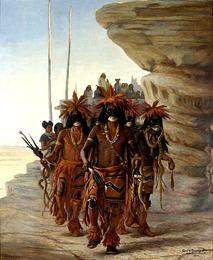
Hopi Snake Dance--
representative work.
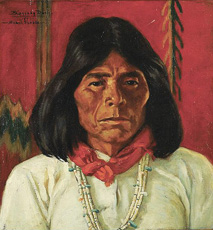
Moqui Pueblo--
representative work.
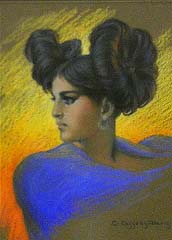
Indian Maiden Portrait--
representative work
Portrait of Jane T. Bowler in the Cinncinati Room
and Portrait of Mrs. W. H. Harrison in the
Assembly Room (images unavailable)--exhibited
in the Women's Building, 1893 Exposition.
Born in Ohio, Cornelia Cassady Davis was one of the twin daughters of druggist/physician George K. Cassady and his wife Anna. She attended the Cincinnati Academy of Art and studied under Lutz, Noble, and Frank Duveneck, and later taught there during the 1890s. With her new husband Edwin C. Davis, she took a two-year honeymoon trip west in 1897 where she worked and lived on the Hopi and Navajo Reservations in Arizona and surrounding areas. In addition to western and Indian themes, she painted a number of portraits, including one of the Governor of the Zuni and, upon her return to Cinncinati in 1905, one of President William McKinley.
![]()
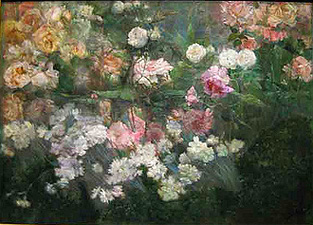
Garden in May 1895--representative work.

Iris at Dawn 1899--
representative work.

Bed of Poppies 1909--
representative work.

The Costumer
1924--representative work.
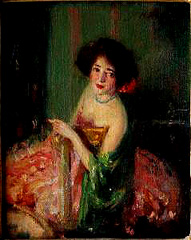
Debutante Smoking
[title unknown]--
representative work.

Spring Flowers with
Roses, Daffodils,Larkspur
1909--representative work.
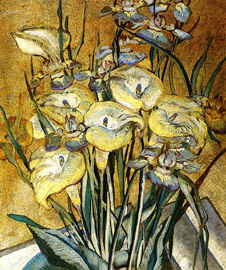
Irises and Calla Lillies
1882-90--
representative work.
It is unclear which work(s) Dewing exhibited at the 1893
Exposition, but several sources state that she won medals (plural).
Maria Oakey Dewing was the child of a New York businessman, William Francis Oakey, and his cultivated Bostonian wife Sally. Maria studied art at the Cooper Union School of Design for Women and with John LaFarge (a major influence on her florals) at the National Academy of Design, as well as with Thomas Couture in Paris in the 1870s. After she married the well-known figure-painter Thomas Wilmer Dewing in 1881 and gave birth to her daughter, she painted only still-lifes (to avoid competing with her husband?). The Dewings spent their summers in the art colony of Cornish, New Hampshire where her garden became famous and the inspiration for many of her paintings. Late in life, she admitted that she regretted abandoning figure paintings. Dewing also wrote articles, poems, and three books.
![]()
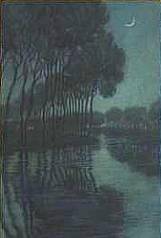
Crescent Moon--
representative work

Italian Canal Scene--
representative work
Mist on the Cornish Coast; Early Morning;
Dordrecht Canal; Sardine Wharf, Eastport ;
Lights of Venice; and others (images unavailable)--
exhibited in the Woman's Building, 1893 Exposition.
Blanche Dillaye was born into a well-to-do New York family and studied art at the Pennsylvania Academy of the Fine Arts and in Paris. She was known for her work in a variety of artistic media (painting, watercolors, etching, jewelry, posters) and as a writer and Director of Art Education at the Pennsylvania Academy of the Fine Arts.
![]()
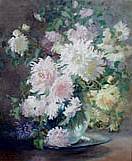
Floral 1890--
representative work.
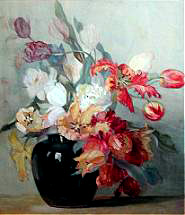
Parrot Tulips in a Black Vase
--representative work.
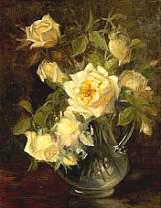
Yellow Roses
--representative work.
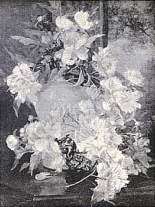
Peonies 1890--
exhibited in the Fine Arts
Palace, 1893 Exposition
Julia Dillon was a Kingston, New York artist who studied in Paris with Georges Jeannin, Harry Thompson, and her cousin Jervis McEntee, a Hudson River School artist, in the 1870s. Still-life paintings of roses, chrysanthemums, and other flowers were her specialty. She married John Dillon; widowed in the 1873, she remained a partner in the family business McEntee and Dillon Rondout Foundry and Machine Shop which helped fund her art career. In 1915 she published the book Old Gardens of Kingston.
![]()
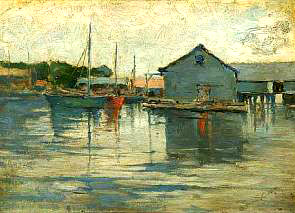
Harbor Scene [title unknown]--representative work

The Old
Picket Fence in a Landscape
1889--exhibited in the Illinois State
Building, 1893 Exposition.
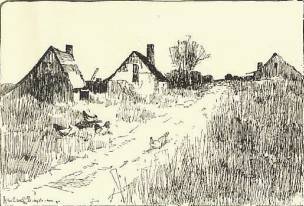
Old
Shanties at St. Joes--
exhibited in the Illinois
State Building, 1893 Exposition.
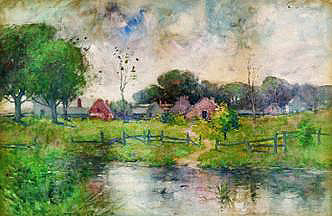
Village Path to the River -- exhibited
in the Illinois State Building, 1893 Exposition
Summer Time and A Little House in the Meadow
(images unavailable)--exhibited in the
Illinois State Building, 1893 Exposition.
Anna Van Cleef Dodgshun was born in New Jersey and studied art under George H. Smillie. She may have also taught art for a time. No other information is available online.
![]()

The Honorable Mrs. Mark
Napier (Gabrielle), daughter
of Viscount Ranleigh--
representative work.
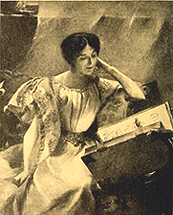
The Reader--
representative work

The Signing of the Declaration of Independence
1883--representative work.

Girls in the Sunlight under the Trees--
representative work.
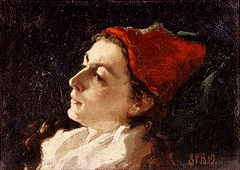
Woman in a Red Cap--
representative work.
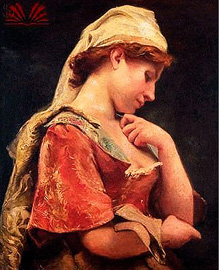
Peasant--
representative work
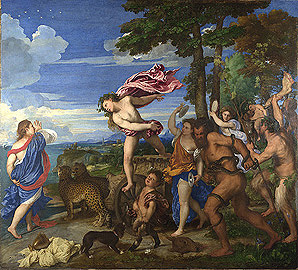
Titian's Bacchus and Ariadne
--representative work.

La Lune
--representative work.

Deborah--
representative work
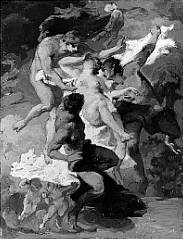
Psyche Carried Away
by the Zephyrs 1883
[Museum of Fine Arts, Boston]
--representative work.
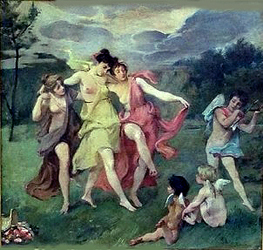
Study for a larger work titled
L'amour Ménétrier (Cupid the Fiddler)
1877--representative work
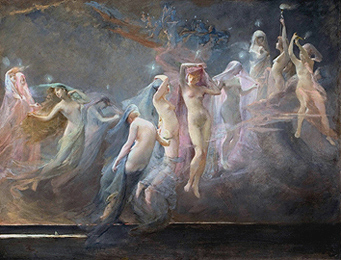
Etoiles du Matin (The Morning Stars)
1887--exhibited in Fine Arts Palace,
1893 Exposition.
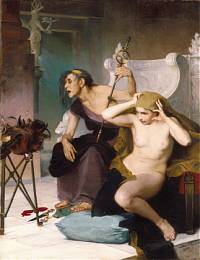
The Bacidae1883 (two
priestessesof Bacis in a prophetic
ecstasy reading chicken entrails)--
representative work.
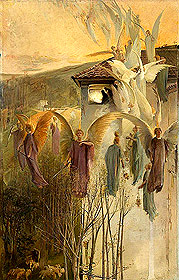
Le Berceau 1903
--representative work.
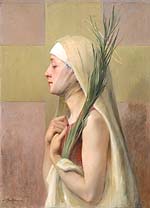
Saint Thekla or Une
Martyre 1891--
[National Museum of
American Art, Smithsonian]
exhibited in Fine Arts
Palace, 1893 Exposition.

Honey of Hymettus
1891--exhibited in
Fine Arts Palace,
1893 Exposition
Wall mural--go to Women's Building page.
Exhibited in Pennsylvania State Building,
1893 Exposition.
Sarah P. Dodson was born in Philadelphia and began her first art studies under Christian Schussele at the Pennsylvania Academy of the Fine Arts after the death of her artist-father who did not encourage her interest in art. After studying in Paris under Evariste Vital Luminais and, later, Jules Lefebvre, she became a permanent expatriate, living in Brighton, England after 1891 and specializing in grand academic paintings on classical and biblical subjects. One of her well-known historical works is her large "The Signing of the Declaration of Independence" 1883. She exhibited often and turned more to landscape painting in her later years.
![]()

Picture Book--representative work.
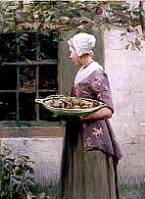
Collecting Pears
c. 1895--
representative work.
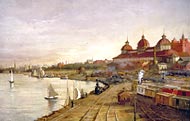
Inter-State Industrial
Exposition 1873
--representative work.
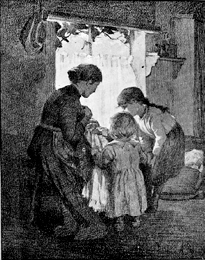
What the Stork Brought c. 1892--
exhibited in the Fine Arts
Palace, 1893 Exposition.
Industrial Arts--go to Women's Building page.
Frieze art exhibited in the Reception Room,
Illinois State Building, 1893 Exposition
A Letter from the Fatherland (image unavailable)--
exhibited in the Illinois Room, 1893 Exposition
Portrait of Mrs. M.W. Means (image unavailable)--
exhibited in the Rotunda, Women's
Building, 1893 Exposition.
Pauline Dohn was one of Chicago's most important women artists at the turn of the century. The daughter of a musician, she studied in Chicago at the Art Institute, in Philadelphia under Thomas Eakins, and in Paris and the Netherlands with Boulanger, Lefebvre, and Lazar. Back in Chicago, she taught at the School of the Art Institute and shared a studio with artist Annie Weaver Jones. She married a Chicago businessman (Rudolph) in 1901. Her painting of the Inter-State Industrial Building is on the cover of Chicago History, Spring 1987.
![]()
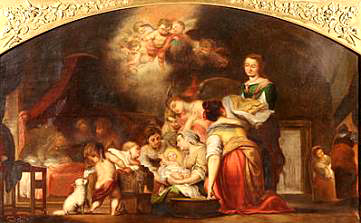
The Adoration 1895--representative work.

Garland
for Putti--
representative work.
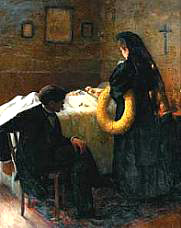
Pause for
Remembrance 1898--
representative work.

The Adoration 1895--representative work.
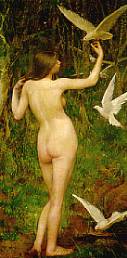
Wood
Nymph 1896--
representative work.
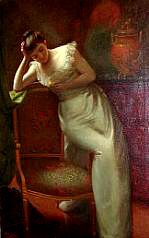
La Fleur
Fané 1892--
representative work.
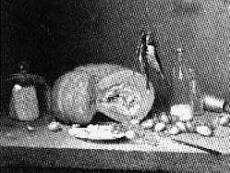
Pumpkins and Onions (Still Life with
Pumpkin and Fish) 1891--exhibited in
the
Fine Arts Palace, 1893 Exposition.
Mattie Thweatt Dubé, the youngest of the ten children of William Archibald Thweatt and Mary Catherine Jarman, was born near Clarendon, Arkansas. After her mother's death, Mattie and a sister were raised by her Jarmon relatives in Alabama. She received her art training first in Nashville, then at the Boston Academy of Fine Arts, and later in Munich and in Paris under W.M. Bouguereau and Tony Robert-Fleury. After she married artist Theodore Dubé de la Garanne, the two maintained a studio in Paris for many years. Although she won medals and other honors in Paris (she was the first woman to receive a gold medal from the Paris Art Salon in 1896), she gave up painting when her beloved daughter Theodora died of T.B. in 1916.
![]()
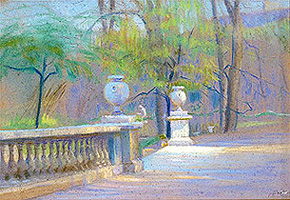
Views of a Formal Garden--representative work.

Pink Roses in a Vase
--representative work.

Oranges and Marmalade 1889
--representative work.
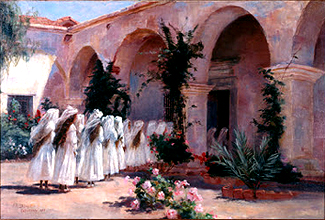
Confirmation Class, San Juan, Capistrano 1897--
exhibited in Fine Art Palace, 1893 Exposition.
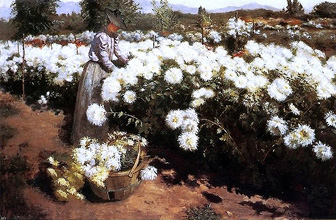
Chrysanthemum Garden in California--
exhibited in Fine Art Palace, 1893 Exposition.
Study of Onions (image unavailable)--
exhibited in Fine Arts Palace, 1893 Exposition.
Fannie Duvall was born in New York and studied at the Art Students League. She taught in Syracuse before moving to Los Angeles. After 1900, she also spent part of her time in Paris studying under Whistler at the Grande Chaumiere. She is remembered for her landscapes and floral still lifes. The painting Chrysanthemum Garden in California (see above) was destroyed in a fire in 1991 in Oakland, CA.
![]()
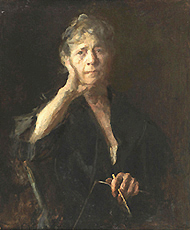
Self-Portrait--representative work.

Portrait of Thomas Eakins 1889--
exhibited in Fine Arts Palace,
1893 Exposition.
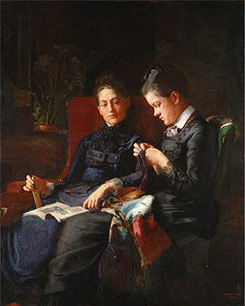
Two Sisters1879
[Mary and Elizabeth Macdowell]
--representative work.
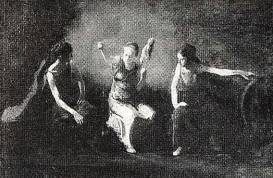
The Three Fates--representative work.

Music 1875--
representative work

Woman Sewing
--representative work.
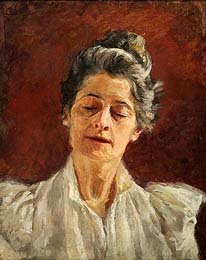
Anguish--
representative work.
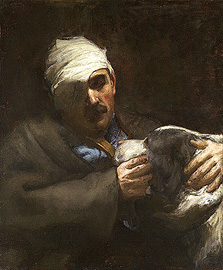
Portrait of Lieutenant
Jean-Julien Lemordant
1917--representative work.
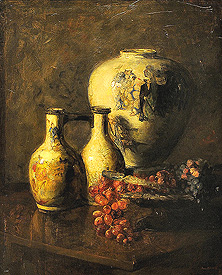
Still Life--representative work.
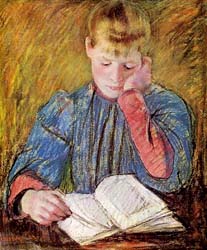
Boy Reading--
representative work.

Woman in Plaid Shawl
--representative work.
Reflection 1881 (image unavailable)--
exhibited in Fine Arts Palace,
1893 Exposition.
Susan Macdowell Eakins was born in Philadelphia where her father was a respected engraver and highly supportive of her artistic interests. After seeing Thomas Eakins' realistic painting The Gross Clinic in 1876, she enrolled in the Pennsylvania Academy of Fine Arts so she could study with him. She painted only sporadically after they married in 1884, but she still managed to win many awards for her portraits and domestic scenes in the academy's annual exhibitions. After his death, she returned avidly to her painting.
![]()

Reading
Study 1876--
representative work.
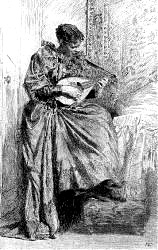
Portrait
Sketch--exhibited in
Women's Building, 1893 Exposition.
Allegra Eggleston was known primarily as an illustrator. She studied at the Cooper Institute in 1875 and in Switzerland (woodcarving), and exhibited annually at the Society of American Artists. At least one book by her father, Edward Eggleston, was illustrated by Allegra.
![]()
![]()
Go to U.S. Women Painters, p. 5
Return to Women Painters Index
Return to Site Index
![]()
![]()
Text written by K. L. Nichols
Painting, top of page: Marie Konstantinovna
Bashkirtseff,
In the Studio (1881).
Return to Nichols Home Page
Suggestions/Comments: knichols11@cox.net
Posted: 6-25-02; Updated: 5-4-20